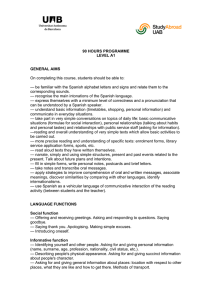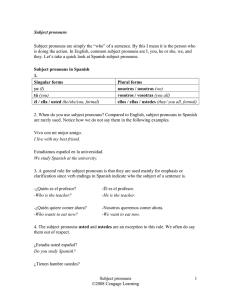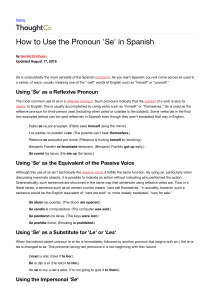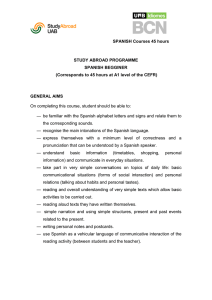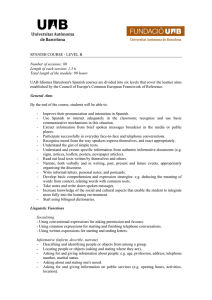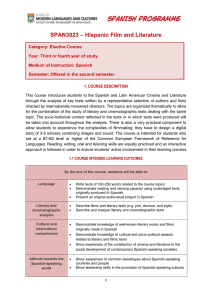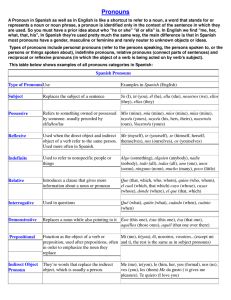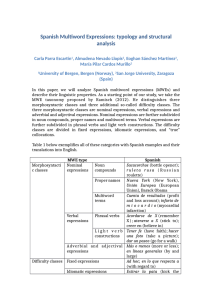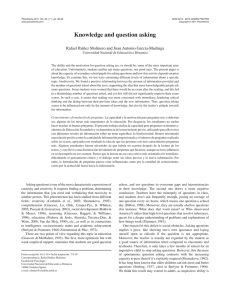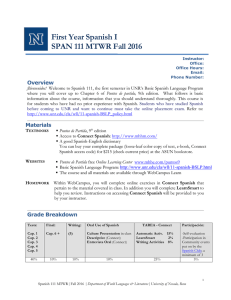Programa del curso (pdf 0,12 MB)
Anuncio
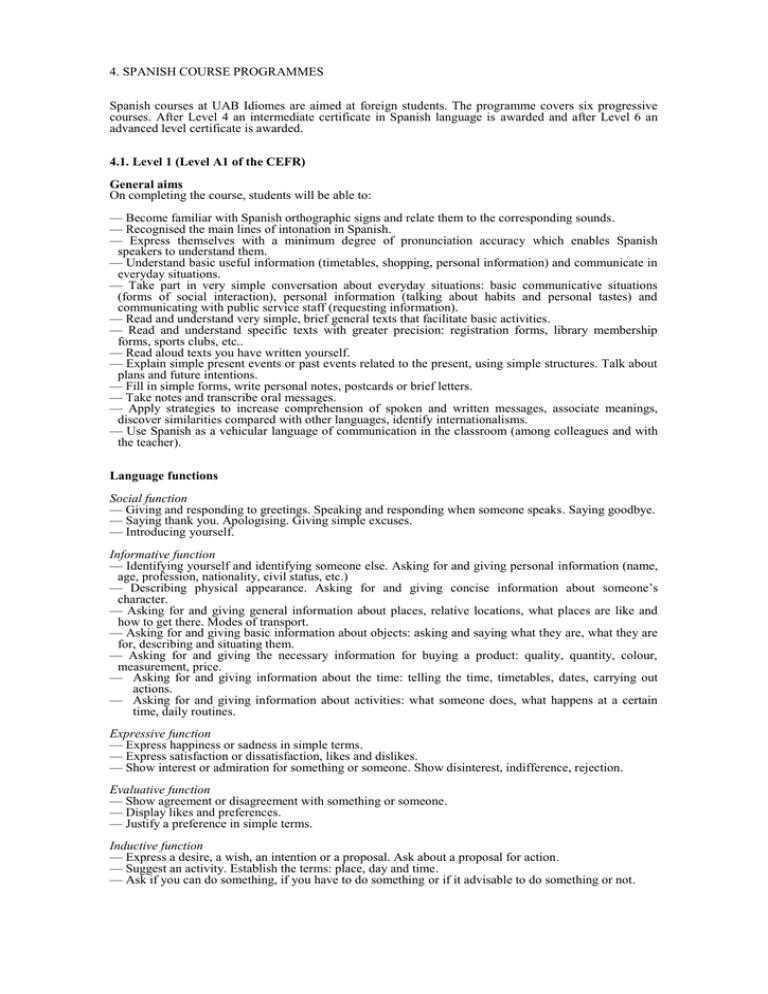
4. SPANISH COURSE PROGRAMMES Spanish courses at UAB Idiomes are aimed at foreign students. The programme covers six progressive courses. After Level 4 an intermediate certificate in Spanish language is awarded and after Level 6 an advanced level certificate is awarded. 4.1. Level 1 (Level A1 of the CEFR) General aims On completing the course, students will be able to: — Become familiar with Spanish orthographic signs and relate them to the corresponding sounds. — Recognised the main lines of intonation in Spanish. — Express themselves with a minimum degree of pronunciation accuracy which enables Spanish speakers to understand them. — Understand basic useful information (timetables, shopping, personal information) and communicate in everyday situations. — Take part in very simple conversation about everyday situations: basic communicative situations (forms of social interaction), personal information (talking about habits and personal tastes) and communicating with public service staff (requesting information). — Read and understand very simple, brief general texts that facilitate basic activities. — Read and understand specific texts with greater precision: registration forms, library membership forms, sports clubs, etc.. — Read aloud texts you have written yourself. — Explain simple present events or past events related to the present, using simple structures. Talk about plans and future intentions. — Fill in simple forms, write personal notes, postcards or brief letters. — Take notes and transcribe oral messages. — Apply strategies to increase comprehension of spoken and written messages, associate meanings, discover similarities compared with other languages, identify internationalisms. — Use Spanish as a vehicular language of communication in the classroom (among colleagues and with the teacher). Language functions Social function — Giving and responding to greetings. Speaking and responding when someone speaks. Saying goodbye. — Saying thank you. Apologising. Giving simple excuses. — Introducing yourself. Informative function — Identifying yourself and identifying someone else. Asking for and giving personal information (name, age, profession, nationality, civil status, etc.) — Describing physical appearance. Asking for and giving concise information about someone’s character. — Asking for and giving general information about places, relative locations, what places are like and how to get there. Modes of transport. — Asking for and giving basic information about objects: asking and saying what they are, what they are for, describing and situating them. — Asking for and giving the necessary information for buying a product: quality, quantity, colour, measurement, price. — Asking for and giving information about the time: telling the time, timetables, dates, carrying out actions. — Asking for and giving information about activities: what someone does, what happens at a certain time, daily routines. Expressive function — Express happiness or sadness in simple terms. — Express satisfaction or dissatisfaction, likes and dislikes. — Show interest or admiration for something or someone. Show disinterest, indifference, rejection. Evaluative function — Show agreement or disagreement with something or someone. — Display likes and preferences. — Justify a preference in simple terms. Inductive function — Express a desire, a wish, an intention or a proposal. Ask about a proposal for action. — Suggest an activity. Establish the terms: place, day and time. — Ask if you can do something, if you have to do something or if it advisable to do something or not. Metalinguistic function — Ask how to say something in Spanish. — Ask and say how to spell a word and which orthographic signs it requires. — Ask and say if you have understood an expression. — Ask for something to be repeated, if someone can speak louder or slower. — Ask for clarification of the meaning of a word or expression. Grammar content Determinants and quantifiers — Definite articles (el, la, los, las) indefinite articles (un, una, unos, unas). — Demonstratives: este/a, ese/a, aquel/lla. — Possessives: mi, tu, su, nuestro/a, vuestro/a, su, mis, tus, sus, nuestros/as, vuestros/as, sus. — Cardinal numbers and the first ordinal numbers. — Grades: muy, bastante, demasiado, poco. Noun and adjective — Agreement of gender and number. Verb — Present indicative use of the most common regular and irregular verbs (trabajar, estudiar, ser, vivir, estar, ir, venir, cerrar, abrir, costar, empezar,…) and the most common time expressions associated with them (siempre, todos los días normalmente, a veces,…). — The verb haber. Uses as verb and as auxiliary verb. — Most commonly used regular and irregular reflexive verbs: llamarse, levantarse, ducharse, acostarse,… — Verbs with emphatic pronouns: gustar, encantar (“a mí me gusta”). — Modal verbs of obligation (tener que), volition (querer) and possibility (poder). — Future expressions. Use of present with future time expressions (mañana, la semana que viene,…). — Indicative past perfect: regular and irregular forms of commonly used verbs: hablar, ver hacer poner, ser,… — Presentation of expressions with estar + gerund. Adverbio — Adverbs of mode: bien, mal, regular,… — Adverbs of place: aquí, allí, cerca, lejos,… — Adverbs of time: ahora, después, luego,… Pronombre — Personal subject pronouns: yo, tú, él,… — Personal direct object pronouns: me, te, lo, la, nos, os, los, las. — Personal indirect object pronouns: me, te, le, nos, os, les. — Reflexive pronouns: me, se te, nos, os, se. — Emphatic pronouns: a mí me, a ti te,… — Interrogative pronouns: qué, cómo, quién, cuándo, por qué,… Preposición — Most commonly used prepositions: a, en, por, para, de,… — Prepositions or prepositional expressions introducing the notion of place: en, entre, encima de, debajo de, dentro de,…. Conjunción — Frenquently used conjunctions: y, o, pero, porque. Léxico — Introduction and familiarisation with the words most often needed for everyday situations. Course texts Course book: — J. Corpas, E. García, A. Garmendia. Aula 1 (libro del alumno). Ed. Difusión Recommended complementary texts: Grammar books — F. CASTRO. Uso de la gramática española (nivel elemental). Ed. Edelsa. — ROSARIO ALONSO et. al. Gramática básica del español. Ed. Difusión — Tablas gramaticales de Español. Ed. Difusión. — M. CORTÉS. Gramática y recursos comunicativos 1 (A1-A2). Ed. Santillana. Dictionaries — Diccionario de bolsillo del español actual. Ed. SGEL.
